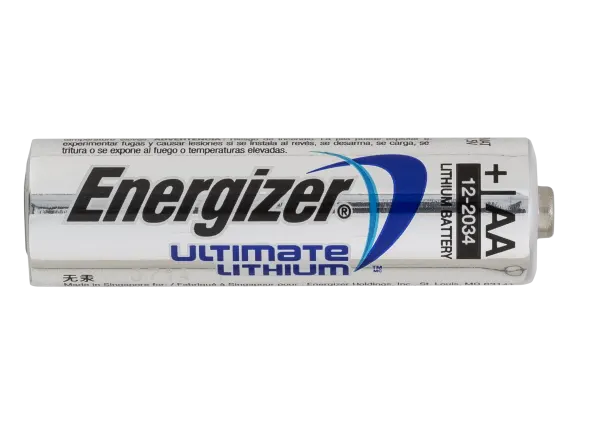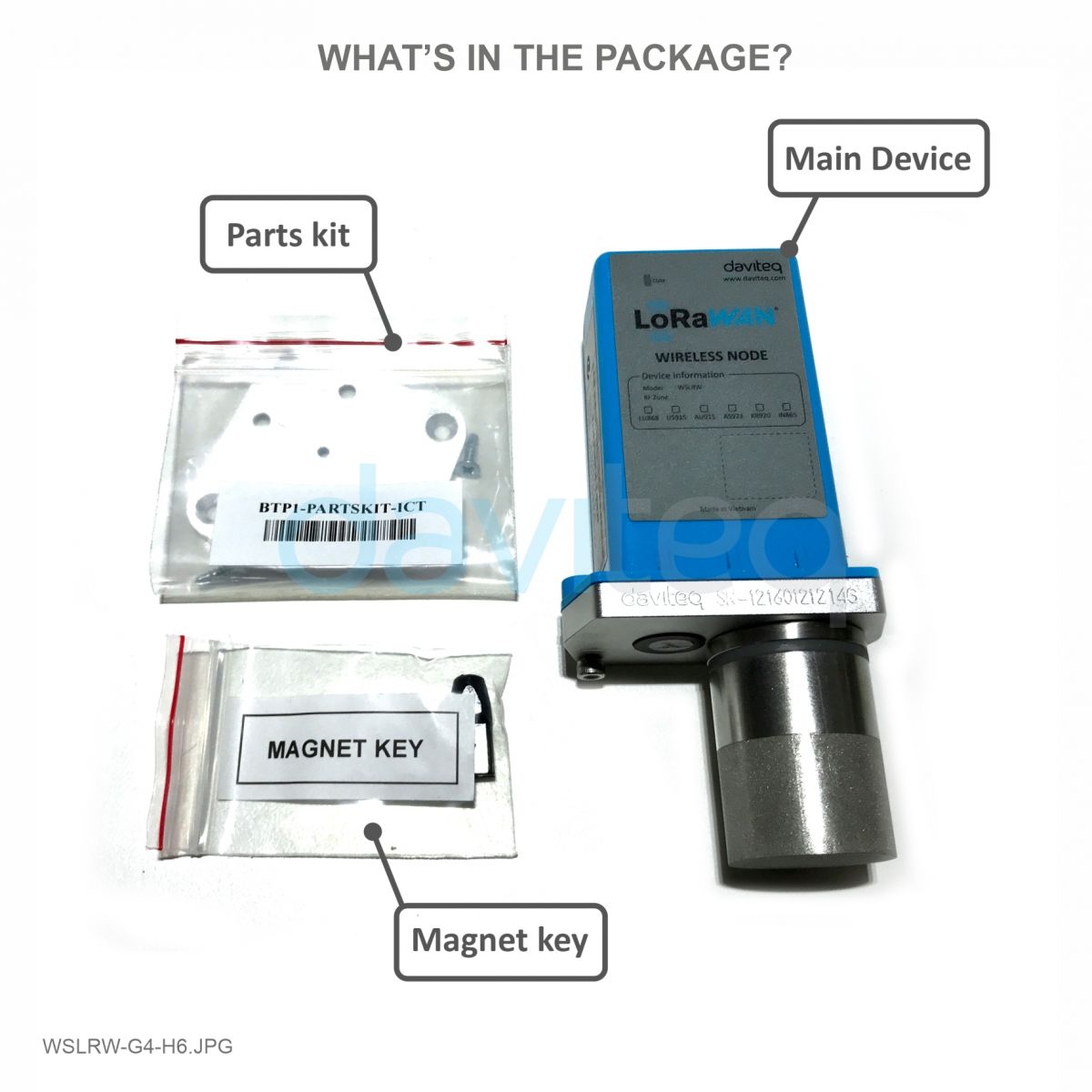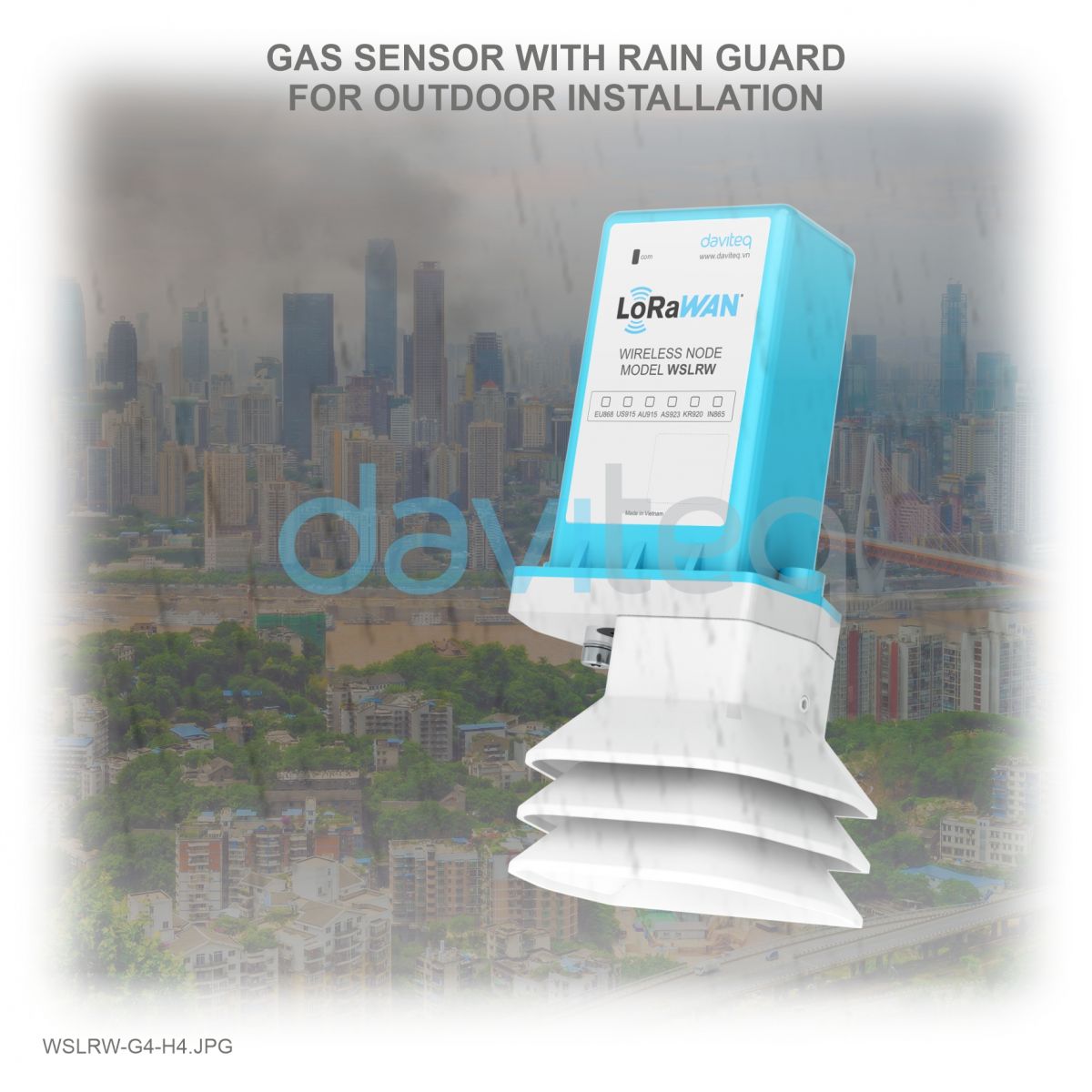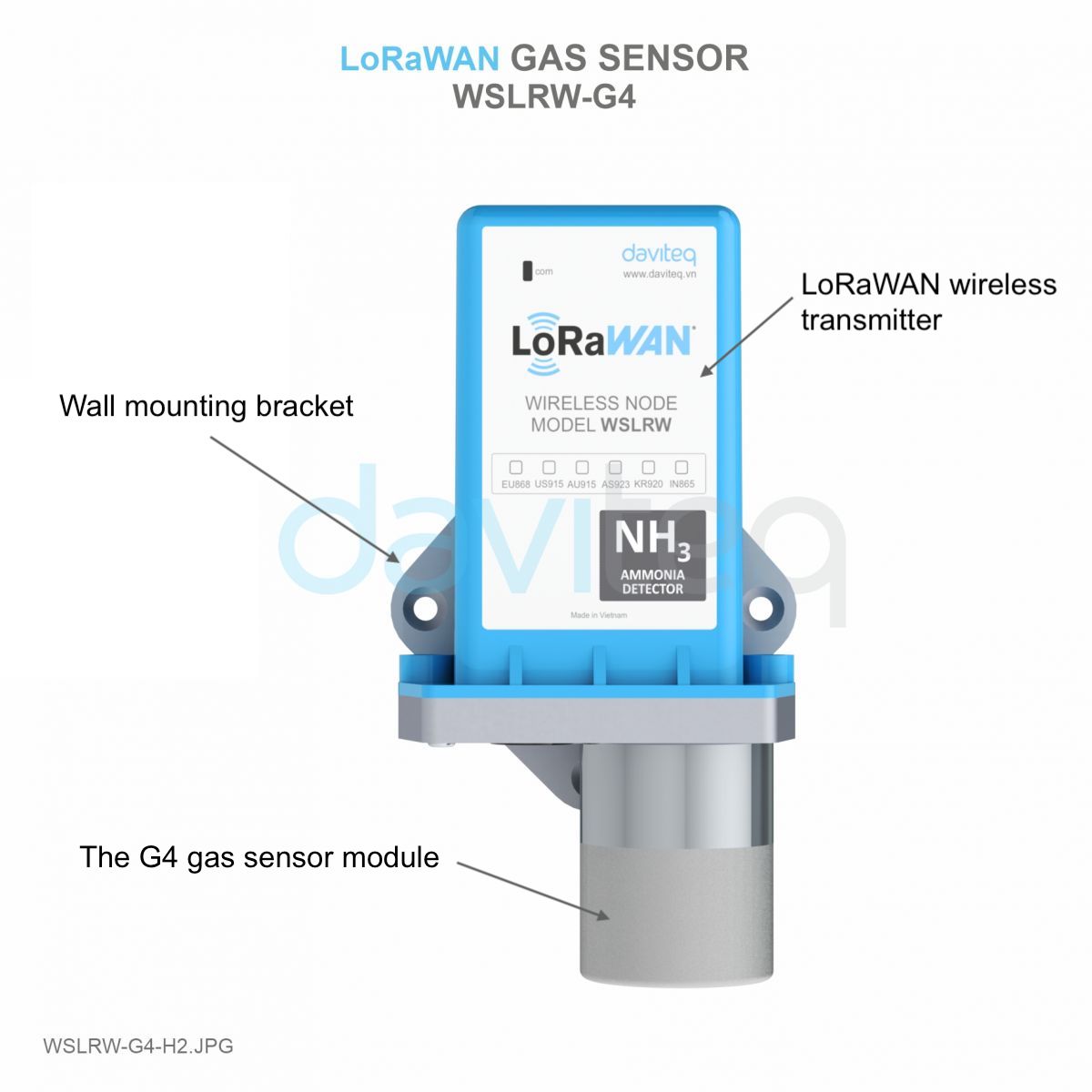Manual for LoRaWAN G4 Gas Sensor - WSLRW-G4 | FW 1.0
THIS IS OBSOLETE MANUAL
Please access https://www.iot.daviteq.com/wireless-sensors for updated manual
Thank you very much for choosing Daviteq Wireless Sensors. We are the leading wireless sensor manufacturer in the World. We have a wide range of wireless sensors which support different connectivity like LoRaWAN, Sigfox, Sub-GHz, NB-IoT...Please find out more information at this link.
This manual is applied to the following products
| Item code | HW Version | Firmware Version | Remarks |
| WSLRW-G4-... | 1 | 1 |
Information Changes in this version v.s previous version
| Item | Changes | Changed by | Changed Date | Approved by | Approved Date |
| 1 | Initial version | P.N.Diep | 22-06-2022 | N.V.Loc | 24-08-2022 |
To use this product, please refer step by step to the below instructions.
| Operating Principle | Uplink Payload |
| Battery | Connect to the LoRaWAN Gateway |
| Installation | Troubleshooting |
| Configuration | Calibration |
| Specification | Warranty and Support |
1. Quick Guide
Reading time: 10 minutes
Finish this part so you can understand and put the sensor in operation with the default configuration from the factory.
1.1 What is the LoRaWAN G4 Gas Sensor and its principle of operation?
WSLRW-G4 is a LoRaWAN electrochemical-type gas sensor with a high sensitivity to low concentrations of detected gas, high selectivity, and a stable baseline. The device supports different types of gas such as CO, NO, NO2, H2S, NH3, O2, O3, SO2, Cl2, HCHO...Ultra-low Power design and smart firmware allow the sensor to last up to 5 years with a 02 x AA-type battery (depends on configuration). The sensor will transmit data at a kilo-meters distance to the LoRaWAN gateway, any brand on the market.
For the principle operation of the G4 Gas Sensor module, please refer to this link.
1.1.1 What are the typical applications of this sensor?
Please refer to this link for typical applications.
1.1.2 When does the device send uplink messages?
The device will send uplink messages in the following cases:
- Case 1: After power-up in the 60s, the device will send the first message called START_UP. The payload will tell the user the HW version, FW version, and current configuration of the device;
- Case 2: Then, in every interval time (pre-configured), for example, 10 minutes, it will send the message called CYCLIC_DATA. The payload will tell the user the following data like measured value, battery level, alarm status...
To change the cycle of data sending, you can change the value of the parameter: CYCLIC_DATA_PERIOD (default is 600 seconds).
- Case 3: If the Alarm function was enabled (in the configuration of the sensor), if the measured value passed the threshold, it will send the uplink message immediately. This message is called ALARM. The payload also tells the user the data like measured value, battery level, alarm status...
The alarm thresholds can be changed via downlink or offline tools.
- Case 4: During commissioning, testing, or calibration sensor, the user can force the device to send the uplink message so that they can get the data immediately. This message is called FORCE_DATA. The payload will provide data like raw measured value, scaled measured value, battery level, alarm status... It can be forced by applying the magnet key on the reed switch in 1s;
- Case 5: If users want to change the configuration immediately, they don't need to wait until the next cyclic data sending message, instead they can force the device to send a special uplink message so that the device can get the new downlink message. This uplink message is named PARAMETERS_UPDATE. It can be forced by applying the magnet key in more than 5s.
1.1.3 The important configuration parameters
The sensor was pre-configured at the factory with default values for configuration parameters that meet most use cases. However, depending on the specific use case, the customer can adjust those parameters. Please refer to section 3.2 for more details.
1.1.4 What kind of battery is used for this sensor?
The sensor is powered by 2 x AA 1.5V batteries for many years of operation. We do recommend using Energizer L91 battery which is very popular and high performance. This battery has a capacity of up to 3500mAh with a working temperature range from -40 to +60 oC. The instruction for installing the batteries is in this link.
For Battery life estimation, please refer to this link.
1.2 What's in the package?
The package includes:
01 x Main device
01 x Magnet key
01 x Wall mounting bracket and screws
1.3 Quick Test for LoRaWAN Sensor
With the default configuration, the device can be connected quickly to the Network Server by the following steps.
Step 1: Prepare the values of communication settings:
| Frequency zone | Most of the sensor was configured the frequency zone to suit customer application before delivery |
| DevEUI | Get the DevEUI on the product nameplate |
| AppEUI | Default value: 010203040506070809 |
| AppKey | Default value: 0102030405060708090A0B0C0D0E0F10 |
| Activation Mode | OTAA with local join server |
| Network Mode | Public |
| LoraWAN Protocol version | 1.0.3 |
| Class | A |
Note: If the above settings do not match your network server/application, please refer to section 3.2 Sensor configuration to change the settings
Step 2: Register the device on the LoRaWAN network server.
Input the above settings on your device registration page of the network server.
Note: Different network server software will have different processes for registering the device. Please refer to the manual of the network server software being used for more details.
Please visit this link to get the instructions for adding the LoRaWAN sensors to some common network servers such as Actility, TTN...
Step 3: Install the batteries to the device
Refer to this link for details.
After installing the battery in 60 seconds, the first data packet will be sent to the LoRaWAN gateway. After receiving the first data packet, the time of another packet depends on the value of the parameter: cycle_send_data. Additionally, you can use a Magnet Key to force the device to send data instantly.
Step 4: Decode the payload of receiving package
Please refer to section 1.4 Uplink Payload and Data Decoding for details of decoding the receiving packet.
1.4 Uplink Payload and Data Decoding
For the Uplink Payload structure, please refer to this link.
Note: Please select the right Payload document to suit the FW version of the sensor
1.5 Sensor Installation
ATTENTION:
- IF INSTALLING THE SENSOR OUTDOORS, PLEASE ATTACH THE RAIN GUARD TO PROTECT THE SENSOR FROM THE RAINDROPS OF SNOW. THE RAIN GUARD IS ALSO A RADIATION SHIELD. PLEASE REFER TO THE BELOW FIGURE.
WARNING:
DO NOT SPRAY THE WATER DIRECTLY TO THE SENSOR AREA (THE BOTTOM PART AND THE VENTING PARTS OF THE RAIN GUARD)
1.5.1 Dimension drawings
1.5.2 Battery Installation
Please follow the instructions in this link.
1.5.3 Sensor calibration and configuration
The LoRaWAN G4 Gas sensor needs to be calibrated for the first use and re-calibrated in the next 6 or 12 months.
It may be pre-calibrated by the manufacturer before shipping. Please check the details in your Purchase order. If so, you can skip this step and proceed to the next step.
1.5.4 Sensor mounting on wall or pole
Please follow this link.
2. Maintenance
2.1 Troubleshooting
- Problems with LoRaWAN communication like not receiving the packets...please refer to this link to troubleshoot the device.
- Problems with the sensor functions like not measuring or inaccurate measuring....please refer to this link to troubleshoot the sensor part.
2.2 Sensor maintenance
2.2.1 Maintenance of Wireless transmitter
| Maintenance works | Yes/No |
Descriptions |
| Consumable parts replacement | Yes |
The battery is the only part need to check the lifetime to replace. Check the battery status on the back-end system. |
| Cleaning device | No |
|
| Re-calibration / Re-validation | No | No calibration is required for the wireless transmitter BUT is needed for the sensor part. |
2.2.2 Maintenance of the G4 Gas sensor module
Please refer to this link.
3. Advanced Guide
3.1 Operating principle of LoRaWAN G4 Gas Sensor
3.1.1 Operating principle of the complete device
The Daviteq LoRaWAN G4 Gas Sensor comprises 02 parts linked internally as shown below picture.
- The Daviteq LoRaWAN wireless transmitter;
- The Daviteq G4 Gas sensor module;
The G4 gas sensor module measures the gas concentration in the surrounding environment.
The LoRaWAN wireless transmitter is to read the measurement values from the G4 sensor and performs the scaling and calculation to deliver the desired output values, then it sends data to the gateway in the following cases:
- Case 1: when the time of the Data sending cycle is reached.
- Case 2: when the measured value is over the preset threshold.
- Case 3: when the device is forced to send data by a Magnet key.
3.1.2 Operating principle of G4 gas sensor module
To understand how the G4 gas sensor module work, please refer to this link for a complete understanding of this measuring technique.
3.1.3 Some important configuration parameters
Below are some important configuration parameters which affect the operation of the device.
- measure_period | Default = 600s
This is the time period for the wireless transmitter to wake up and take the measurement from the sensor. The default value is 600s. Users can reduce this value, but smaller value, shorter battery life! - cyclic_data_period | Default = 600s
Interval time to send an uplink message regardless of any conditions - constant_A | Default = calibrated value by factory
This value will affect the measurement accuracy. DO NOT change this value! - constant_B | Default = calibrated value by factory
This value will affect the measurement accuracy. DO NOT change this value! - sensor+amplifier_sensitivity | Default = calibrated value by factory
This value will affect the measurement accuracy. DO NOT change this value!
Those configuration parameters can be changed by downlink or offline tools. For more other configuration parameters, please refer to the next section.
3.2 Sensor Configuration
3.2.1 How to configure the LoRaWAN sensor?
Sensor configuration can be configured in 02 methods:
- Method 1: Configuring via Downlink message. Please find the instructions in this link, but please take note of the FW version of the Document.
- Method 2: Configuring via offline cable.
Note: THE SENSOR IS ONLY ACTIVE FOR OFFLINE CONFIGURATION IN THE FIRST 60 SINCE POWER UP BY BATTERY OR PLUGGING THE CONFIGURATION CABLE.
3.2.2 What parameters of the device are configured?
- Some parameters are read-only, and some are read and writeable.
- To read the parameters, use the off-line cable as above instruction.
- To write the parameters, use the off-line cable or downlink as above instructions.
Below tables are the lists of the parameters of the device.
Read-only Parameter Table
|
Modbus Register (Decimal) |
Modbus Register (Hex) |
Function Code |
# of Registers |
Description |
Range |
Default |
Format |
Property |
Comment |
|
0 |
0 |
3 |
5 |
device info |
|
string |
Read |
Wireless Sensor LoRaWAN G4 Gas Sensor |
|
|
5 |
5 |
3 |
4 |
firmware version |
|
1.00ddmm |
string |
Read |
ddmm = day / month |
|
9 |
9 |
3 |
2 |
hardware version |
|
1.10 |
string |
Read |
|
|
11 |
B |
3 |
4 |
lorawan protocol version |
|
01.01.00 |
string |
Read |
LoRaWAN v1.0.3 |
|
15 |
F |
3 |
6 |
application version |
|
01.03.00.00 |
string |
Read |
application server v1.3.0.0 |
|
21 |
15 |
3 |
6 |
mac layer version |
|
04.04.02.00 |
string |
Read |
mac layer v4.4.2.0 |
|
27 |
1B |
3 |
4 |
deviceEUI |
|
|
hex |
Read |
End Device's EUI number, used to register the product on the Network Server by OTAA |
|
31 |
1F |
3 |
4 |
Lora appEUI |
|
|
hex |
Read |
Application server's EUI number is used to register the product on the Network Server by OTAA |
|
35 |
23 |
3 |
8 |
Lora appKey |
|
|
hex |
Read |
The number of keys used to create two security keys of the End Device, used to register the product on the Network Server by OTAA |
|
43 |
2B |
3 |
8 |
Lora nwkSkey |
|
|
hex |
Read |
key number encrypts the communication command of the MAC layer of the End Device, which is used to register the product on the Network Server by ABP |
|
51 |
33 |
3 |
8 |
Lora appSkey |
|
|
hex |
Read |
End Device data encryption key number, used to register the product on the Network Server by ABP |
|
59 |
3B |
3 |
2 |
device address |
|
0 |
uint32 |
Read |
End Device address created by the Application server, used to register the product on the Network server by ABP |
|
61 |
3D |
3 |
2 |
network ID |
|
0 |
uint32 |
Read |
Network server ID number, used to register the product on the Network server by ABP |
|
63 |
3F |
3 |
2 |
join mode |
|
OTAA |
string |
Read |
OTAA: Over-the-Air activation, ABP: Activation by Personalization |
|
65 |
41 |
3 |
4 |
network mode |
|
PUBLIC |
string |
Read |
PUBLIC, PRIVATE |
|
69 |
45 |
3 |
3 |
region code |
|
AS923 |
string |
Read |
1: AS923, 2: KR920, 3: AU915, 4: US915, 5: EU868, 6: IN865, 7: RU864, 8: CN779, 9: CN470, 10: EU433 |
|
72 |
48 |
3 |
4 |
data rate |
|
DR2:980 |
string |
Read |
DR0:250, DR1:440, DR2:980, DR3:1760, DR4:3125, DR5:5470 |
|
76 |
4C |
3 |
3 |
bandwidth |
|
BW125 |
string |
Read |
BW125, BW250, BW500 |
|
79 |
4F |
3 |
2 |
spread factor |
|
SF10 |
string |
Read |
SF12, SF11, SF10, SF9, SF8, SF7 |
|
81 |
51 |
3 |
4 |
activation of ADR |
|
ADR OFF |
string |
Read |
ADR ON, ADR OFF |
|
85 |
55 |
3 |
1 |
class |
|
A |
string |
Read |
|
|
103 |
67 |
3 |
1 |
sensor type |
1-255 |
|
uint16 |
Read |
1-254: sensor type, 255: no sensor |
|
104 |
68 |
3 |
1 |
battery level |
0-3 |
|
uint16 |
Read |
4 levels of battery capacity status |
Read/Write Parameter Table
Note: Please check the column Property to identify which parameter requests a password for writing a new value. In this case, the user needs to input the password (190577) into the parameter name "password for setting" at address 268.
|
Modbus Register (Decimal) |
Modbus Register (Hex) |
Function Code |
# of Registers |
Description |
Range |
Default |
Format |
Property |
Comment |
|
256 |
100 |
3 / 16 |
1 |
Modbus address |
1-247 |
1 |
uint16 |
R/W |
Modbus address of the device |
|
257 |
101 |
3 / 16 |
1 |
Modbus baudrate |
0-1 |
0 |
uint16 |
R/W |
0: 9600, 1: 19200 |
|
258 |
102 |
3 / 16 |
1 |
Modbus parity |
0-2 |
0 |
uint16 |
R/W |
0: none, 1: odd, 2: even |
|
259 |
103 |
3 / 16 |
9 |
serial number |
|
|
string |
R/W (Password) |
|
|
268 |
10C |
3 / 16 |
2 |
password for setting |
|
|
uint32 |
R/W (Password) |
password 190577 |
|
270 |
10E |
3 / 16 |
4 |
Lora appEUI |
|
|
hex |
R/W (Password) |
Application server's EUI number, used to register the product on the Network Server by OTAA |
|
274 |
112 |
3 / 16 |
8 |
Lora appKey |
|
|
hex |
R/W (Password) |
The number of keys used to create two security keys of the End Device, used to register the product on the Network server by OTAA |
|
282 |
11A |
3 / 16 |
8 |
Lora nwkSkey |
|
|
hex |
R/W (Password) |
key number encrypts the communication command of the MAC layer of the End Device, which is used to register the product on the Network Server by ABP |
|
290 |
122 |
3 / 16 |
8 |
Lora appSkey |
|
|
hex |
R/W (Password) |
End Device data encryption key number, used to register the product on the Network Server by ABP |
|
298 |
12A |
3 / 16 |
2 |
device address |
|
|
uint32 |
R/W (Password) |
End Device address created by the Application server, used to register the product on the Network server by ABP |
|
300 |
12C |
3 / 16 |
2 |
network ID |
|
|
uint32 |
R/W (Password) |
Network server ID number, used to register the product on the Network server by ABP |
|
302 |
12E |
3 / 16 |
1 |
activation mode (join mode) |
0-1 |
1 |
uint16 |
R/W (Password) |
1: OTAA (Over-the-Air Activation), 0: ABP (Activation by Personalization) |
|
303 |
12F |
3/16 |
1 |
downlink flag |
0-1 |
1 |
unint16 |
R/W |
1: Enable |
|
304 |
130 |
3 / 16 |
1 |
application port |
1-255 |
1 |
uint16 |
R/W (Password) |
Port 224 is reserved for certification |
|
305 |
131 |
3/16 |
1 |
network mode |
0-1 |
1 |
uint16 |
R/W |
1: Public, 0: Private |
|
317 |
13D |
3 / 16 |
1 |
region |
1-7 |
1 |
uint16 |
Read/Write(Password) |
1: AS923, 2: KR920, 3: AU915, 4: US915, 5: EU868, 6: IN865, 7: RU864, 8: CN779, 9: CN470, 10: EU433 |
|
318 |
13E |
3 / 16 |
1 |
data rate |
|
7 |
uint16 |
R/W (Password) |
0: 250 bps, 1: 440 bps, 2: 980 bps, 3: 1760 bps, 4: 3125 bps, 5: 5470 bps |
|
319 |
13F |
3 / 16 |
1 |
tx power |
2-20 |
16 |
uint16 |
R/W (Password) |
tx power: 2,4,6,8,10,12,14,16,18,20 |
|
320 |
140 |
3 / 16 |
1 |
adaptative data rate |
0-1 |
0 |
uint16 |
R/W (Password) |
Automatically adjust data rate, 0: disable, 1: enable |
|
330 |
14A |
3/16 |
4 |
current_configuration |
|
|
hex |
R/W |
current configuration code of the device |
|
334 |
14E |
3 / 16 |
2 |
constant_A |
|
1 | float |
R/W |
constant_A for scaling measured value |
|
336 |
150 |
3/16 |
2 |
constant_B |
|
0 |
float |
R/W |
constant_B for scaling measured value |
|
338 |
152 |
3/16 |
2 |
high_cut |
|
1E+09 |
float |
R/W |
High cut value for the scaled value |
|
340 |
154 |
3 / 16 |
2 |
low-cut |
|
0 | float |
R/W |
Low cut value for the scaled value |
|
344 |
158 |
3/16 |
2 |
sensor+amplifier_sensitivity |
|
11 |
float | R/W |
Sensitivity value of sensor and amplifier circuit. |
3.3 Calibration or commissioning for G4 sensor
Please refer to this link.
4. Product specification
Please refer to the detailed specifications in this link.
5. Warranty and Support
For warranty terms and support procedures, please refer to this link.
6. References
Use-cases:
Case studies:
White-papers:
END.






No Comments